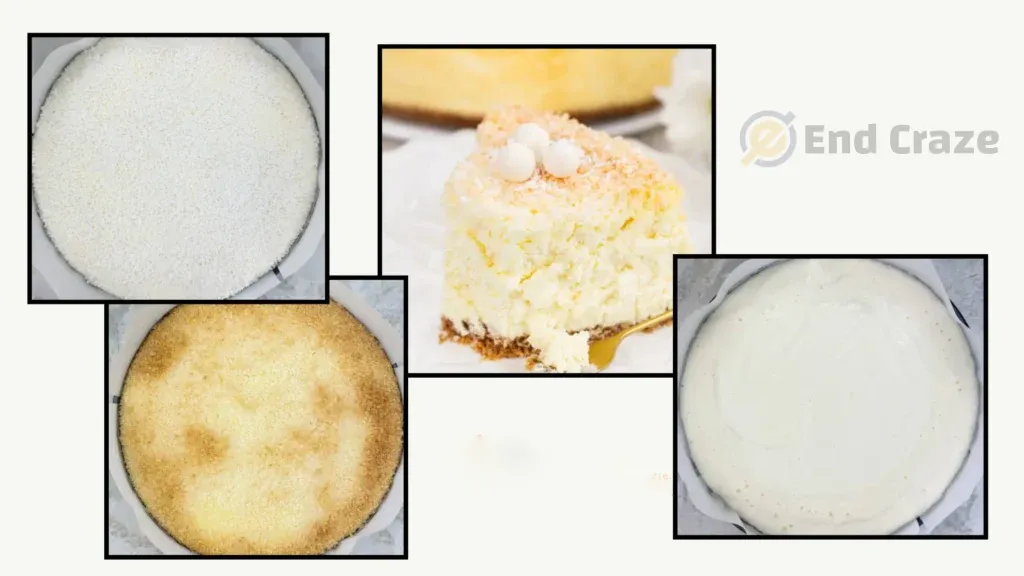The texture of baked coconut cheesecake is delicate and incredibly exquisite, complemented by its powerful coconut taste. The recipe is easy to follow, and the cheesecake has a distinct flavor that is silky and light.
Bottom elements
200 g digestive cookies (whole grain, coconut, oat)
Coconut cheesecake ingredients
- One kilogram (100 g) of premium desiccated coconut, crushed, semi-skimmed, or fatty cottage cheese, or roughly one cup
- 150 g of powdered sugar, or almost half a cup
- 100 grams of thick coconut milk and white mass
- around 200 g, or three large or four little eggs
- One sachet of lemon jelly, either sweetened with sugar or not
- The ornamental application of syntax Half a cup, or 50 grams, of coconut flakes
- a few well-liked coconut medications (unknown origin)
Cheesecake with coconuts
Step 1: Place the mold’s bottom inside.
Fill the food processor bowl with 200 grams of cookies. Blend them with the sand. If your equipment is low-power and your chamber is small, I would recommend grinding a few cookies at a time and putting the ground cookies in a bowl. If you do not have a food processor, you can use a rolling pin to mash the cookies or pound them in a container or string bag using a wooden pestle with a round head.
Get the baking pan ready. A 24-cm-diameter cake tin was utilized. Line the pan with parchment or baking paper on the sides and bottom, then secure the rim. To ensure that the paper sticks well, grease the interior surfaces with soft butter. Arrange the taller strips of baking paper on the greased sides (you will need to cut them yourself from a sheet of baking paper).
Pat the dough to smooth the top after adding it to the pan. For this, you can use a pastry spatula or a tablespoon. Keep the form with the prepared base on the kitchen counter while you make the cheese mass.

Advice: If you’re thinking about making cheesecake, try some good cereal cookies, like oatmeal or whole grains. I created cereal cookies with crushed coconut inside this time.
Step 2: Combine eggs and sugar and beat.
Transfer around 150 grams of powdered sugar (I used 200 grams total after breaking four tiny or three large eggs) into a large bowl. Beat the eggs and sugar together with a mixer set to high speed until the sugar is fully dissolved. The mixture should be light and fluffy after whipping. It could take up to fifteen minutes to whip (or five to eight minutes if you have a good mixer).
Step 3: Combine the leftover components.
To make the second bowl, add one kilogram of finely chopped cottage cheese (I do not suggest using thin, sour cottage cheese from a bucket) or smash the same quantity of semi-skimmed cottage cheese twice. Add a sachet or packet of sugar-containing or sugar-free lemon jelly as well.
Pour in 100 g of thick (white mass) coconut milk and 100 g of coconut flakes. Blend all the ingredients together thoroughly by using a mixer set on low speed. You’ll find it easier to incorporate it into the mass of fluffy eggs as a result.
Advice: You don’t have to use coconut milk, so feel free to omit it.
Step 4: Stir and soften the cheese.
Begin incorporating the egg fluff into the cheese blend. The best course of action is to take numerous approaches. After combining everything on low speed for each step, use a spatula to gently but completely incorporate the cheesecake mixture in the latter stages.
Step 5: Pour the mixture into the mold.
Transfer the mixture gently to the tray with the cookie bottoms on it. My cheese mixture was medium-thick and had the consistency of warm pudding.
Step 6: Top with the shavings.
Cover the cheesecake’s surface with a thin layer of coconut flakes. I offered them roughly 50 grams.
Bake the cheesecake in Step 7.
I don’t utilize the steam feature when making cheesecake. I also steer clear of water bathing since, given a thinner bulk, I don’t mind if it splits somewhat or not at all when it bakes.
Preheat the oven to 160 degrees (or a little lower), place the cheesecake pan inside, and bake for 90 minutes on the top/bottom setting. After turning off the oven, wait at least ten minutes before opening the door.
After that, keep them slightly ajar for 30 minutes. The coconut cheesecake should then be taken out of the oven. After the cheesecake cools, cover it with a lid and refrigerate it for at least four hours, or even better, overnight. This is so that it can reach its ideal structure after cooling.

Advice: If the cheesecake top is too near the heaters and it starts to brown too much while baking, lower the burner power by 10 degrees. I would recommend baking the cheesecake for another 20 minutes if the cheese mixture was really thin.
Step 8: Display and set up
Before serving, the cheesecake can be further embellished if you’d like. I recommend coconuts, coconut dragees, coconut wafers, and wafer rolls with coconut cream.
Under the shade of the light, store the baked and cooled coconut cheesecake in the refrigerator. It will keep fresh for at least a week if kept in the refrigerator between 6 and 10 degrees.
Enjoy!


